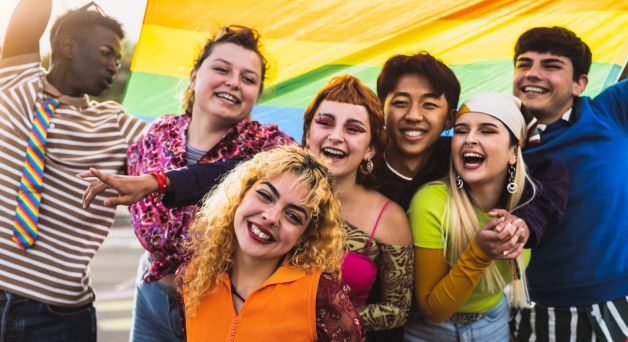Youth who receive special education services under the Individuals with Disabilities Education Act (IDEA 2004) and especially young adults of transition age, should be involved in planning for life after high school as early as possible and no later than age 16. Transition services should stem from the individual youth’s needs and strengths, ensuring that planning takes into account his or her interests, preferences, and desires for the future.
Sexual Orientation and Gender Identity

Sexual orientation and gender identity/expression are important aspects of a young person’s identity. Understanding and expressing sexual orientation and gender and developing related identities are typical development tasks that vary across children and youth. For example, some youth may be unsure of their sexual orientation, whereas others have been clear about it since childhood and have expressed it since a young age.1 Expressing and exploring gender identity and roles is a part of normal development. 2 The process of understanding and expressing one’s sexual orientation and gender identity is unique to each individual. It is not a one-time event and personal, cultural, and social factors may influence how one expresses their sexual orientation and gender identity.3
There is currently no universally-accepted acronym inclusive of all youth who are not heterosexual and/or express their gender in diverse ways. The commonly-used acronym — LGBTQ+ (lesbian, gay, bisexual, transgender, queer or questioning, or another diverse gender identity) — refers to the communities included in the “LGBTTTQQIAA” acronym (see Figure 1). This youth topic primarily uses “LGBTQ+” as an inclusive term for simplicity, except when describing research studies explicitly focused on more narrowly-specific communities. See Key Terms and Concepts to learn more about each of these communities.
Figure 1: Communities included in the “strong LGBTTTQQIAA” acronym*
| Based on Sexual Orientation | Based on Gender Identity/Expression |
|---|---|
Lesbian Gay Bisexual 2/Two-Spirit Queer Questioning Intersex Asexual Pansexual | + Agender + Bigender + Genderqueer + Gender Variant + Nonbinary + Pangender + Transgender + Transsexual |
*See the Key Terms and Concepts page for definitions and citations for each term in the table.
Resiliency and Protective Factors
Research on LGBTQ+ youth has focused on the risk factors and disparities these young people experience compared with youth who are not LGBTQ+. However, more recently there has been research on resiliency and protective factors, which offers a strength-based focus on LGBTQ+ youth well-being. For instance, LGBTQ+ youth who have access to spaces that affirm their sexual orientation and gender identity report lower rates of attempting suicide4 and experiencing supportive environments.5
Several factors that can help improve outcomes for LGBTQ+ young people include:
- Addressing LGBTQ+-related stigma, discrimination, and violence
- Building on the strengths of LGBTQ+ youth
- Fostering supports such as family acceptance and safe, affirming environments in schools and other settings
Federal and local policies and practices increasingly acknowledge and focus on the experiences and needs of LGBTQ+ youth. Numerous national advocacy and other organizations are also giving greater attention to LGBTQ+ youth in their work.6 Fostering safe, affirming communities and youth-serving settings such as schools for all youth requires efforts to address the challenges described here. At the same time, it is also important to acknowledge and build on the strengths, resilience, and factors that protect LGBTQ+ youth from risk, such as connection to caring adults and peers and family acceptance. Parental support of sexual orientation and gender expression provide uniquely strong benefits to positive well-being and mental health in young adulthood and are related to higher levels of self-esteem and lower levels of depression, suicidal ideation, and suicide attempts.7
Young people who identify as LGBTQ+ can experience various challenges because of how others respond to their sexual orientation or gender identity/expression. This is also true for youth who are questioning their sexual orientation or gender identity, or may be perceived as LGBTQ+ or gender variant by others.8 In a 2021 survey of nearly 35,000 LGBTQ+ youth, 75 percent reported having experienced discrimination based on their sexual orientation or gender identity at least once in their lifetime.9 These negative experiences include high rates of physical and emotional bias and violence; rejection by schools, employment, and communities because of their sexual orientation and/or gender identity/expression.
Research shows that due to these challenges and the associated stress, LGBTQ+ youth are at risk for negative health outcomes and are more likely to attempt suicide, experience homelessness, and use illegal drugs10 These issues may also contribute to anxiety, depressive symptoms, and feelings of isolation. Youth who express their gender in ways that vary from societal expectations for their perceived sex or gender are at risk for high levels of childhood physical, psychological, and sexual abuse.11 They are also at risk for school victimization.12 As a result, they may have poorer well-being than lesbian, gay, and bisexual peers whose gender expression is more closely aligned with societal expectations.13
Resources
Emerging Practices for Supporting LGBTQI+ Young People Across Human Services
This project highlights promising and emerging practices that human services agencies, programs, staff, and leaders are using to make human service delivery and prevention more welcoming and accessible for LGBTQI+ young people (ages 10-24) in child welfare and juvenile justice systems, experiencing homelessness, and/or seeking sexual health services. The Open Letter of Action from Young People provides perspectives from five young adults on barriers faced by LGBTQI+ young people and opportunities to improve human services programs across sectors and levels of government to better serve LGBTQI+ young people and their families.
Health Considerations for LGBTQ Youth
This website provides information on protective factors and data related to health risks and sexual minority youth, as well as related resources.
Practice Brief 1: Providing Services and Supports for Youth Who Are Lesbian, Gay, Bisexual, Transgender, Questioning, Intersex, or Two-Spirit (LGBTQI2-S)(PDF, 8 pages)
This practice brief outlines key information for working with and providing culturally and linguistically competent services to LGBTQI2-S youth.
References
1 Poirier, Fisher, Hunt, & Bearse, 2014
2 Poirier, Fisher, Hunt, & Bearse, 2014
3 Poirier, Fisher, Hunt, & Bearse, 2014
4 The National Trevor Project, 2021
5 Day, Ioverno, & Russell, 2019
6 American Association of School Administrators et al., n.d.; National Association of School Nurses, 2003; National Association of School Psychologists, 2006
7 Shilo & Savaya, 2011; Sheets & Moor, 2009; Ryann et al., 2010; Snapp et al., 2015; Russell & Fish, 2016
8 Gender variant youth are not necessarily LGBT. In fact, any youth who does not fit typical social expectations for his or her mannerisms, behavior, or choice of clothing based on birth-assigned gender, for example, can be considered “gender variant.” This does not mean the youth is lesbian, gay, or bisexual — or identifies as a gender different from what he or she was assigned at birth (i.e., transgender).
9 The National Trevor Project, 2021 (45 percent of this sample were youth of color, and 38 percent were transgender or nonbinary.
10 Hunter & Schaecher, 1987; Reis, 1999; Reis & Saewyc, 1999; Ray, 2006; Ryan, Huebner, Diaz, & Sanchez, 2009; SAMHSA, 2014
11 Roberts, Rosario, Corliss, Koenen, & Austin, 2012
12 Toomey, Ryan, Diaz, & Russell, 2010
13 Rieger & Savin-Williams, 2012
Other Resources on this Topic
Announcements
Briefs
Collaboration Profiles
Feature Articles
Publications
Resources
Technical Assistance
Tools & Guides
Videos & Podcasts
Websites
Youth Topics
Youth Briefs
Research links early leadership with increased self-efficacy and suggests that leadership can help youth to develop decision making and interpersonal skills that support successes in the workforce and adulthood. In addition, young leaders tend to be more involved in their communities, and have lower dropout rates than their peers. Youth leaders also show considerable benefits for their communities, providing valuable insight into the needs and interests of young people
Statistics reflecting the number of youth suffering from mental health, substance abuse, and co-occurring disorders highlight the necessity for schools, families, support staff, and communities to work together to develop targeted, coordinated, and comprehensive transition plans for young people with a history of mental health needs and/or substance abuse.
Nearly 30,000 youth aged out of foster care in Fiscal Year 2009, which represents nine percent of the young people involved in the foster care system that year. This transition can be challenging for youth, especially youth who have grown up in the child welfare system.
Research has demonstrated that as many as one in five children/youth have a diagnosable mental health disorder. Read about how coordination between public service agencies can improve treatment for these youth.
Civic engagement has the potential to empower young adults, increase their self-determination, and give them the skills and self-confidence they need to enter the workforce. Read about one youth’s experience in AmeriCorps National Civilian Community Corps (NCCC).
53% of transgender people report being verbally harassed or treated disrespectfully in public places, and 44% have been denied service.
REVIEW THE GUIDE: RESPONDING TO TRANSGENDER VICTIMS OF SEXUAL ASSAULT






